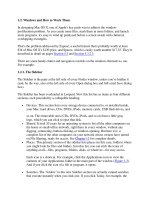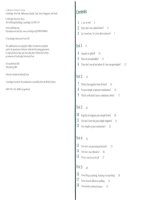7Types of Hard CISSP Exam Questions and How To Approach Them
Bạn đang xem bản rút gọn của tài liệu. Xem và tải ngay bản đầy đủ của tài liệu tại đây (110.72 KB, 7 trang )
7 Types of Hard
CISSP Exam Questions
and How To Approach
Them
1-800-COURSES
www.globalknowledge.com
Expert Reference Series of White Papers
Introduction
The first thing most people hear about the CISSP examination is how difficult or unfair the questions are.
Although this may be a good warning, it does not begin to prepare you to do well on the exam itself. For some
of the CISSP exam questions, just knowing the facts is not enough. These questions are referred to as “hard
questions“. This paper examines seven types of hard questions you are likely to see on the CISSP examination
and the best approaches for solving them.
Throughout the CISSP preparation course offered by Global Knowledge, we cover the various security mecha-
nisms, principles, concepts, and facts that will be included on the CISSP exam. A large portion of the CISSP
examination will test your knowledge of these aspects. However, the mere knowledge of these aspects does
not prepare you for the more difficult questions you may see on the CISSP examination. This is why the Global
Knowledge CISSP preparation class is not limited to a review of the information security mechanisms
, princi-
ples, concepts, and facts. A significant portion of the course is devoted to study skills, memorization tech-
niques, application of concepts, and principles. Although it is impossible to predict exactly what questions you
may get on the exam, we have classified the difficult questions into seven categories and given examples and
approaches for identifying and overcoming them.
1.1 Detailed Knowledge Questions
Description
Requires a detailed knowledge of a technology or principle.
Example Question
At what level of the OSI model can a pack
et be corrected on the bit level?
a) Level 2
b) Level 3
c) Level 4
d) Level 5
Answer
The correct answer is a) Level 2. Level 2 is the data link level. More specifically, Media Access Control is a sub
level of Level 2 that performs error control.
If a single bit is in error
,
it can either flag it as an error or, in the case
of parity bits
,
it can rebuild the frame and perform a bit-level error correction. Also note that Level 4 (transport)
also performs error control, but it is based on a packet. If an error is detected at Level 4 it can only request a re-
transmission. This is just a hard question. You may know the OSI stack very well and still miss this question.
Doug Landoll, General Manager, Security Services, En Pointe, CISSP, CISA
7 Types of Hard CISSP Exam Questions
and How To Approach Them
Copyright ©2006 Global Knowledge T
raining, LLC. All rights reserved.
Page 2
Approach
Study well, and think the question through. Even though the CISSP is commonly described as “a mile wide and
an inch deep”, you still have to know the security-relevant aspects of mechanisms and techniques. Take sever-
al approaches at comparing and contrasting similar and alternative mechanisms. For example, error correction
can be done at Level 2, Level 4, and even Level 7. Ask yourself, “What is the difference between error correc-
tion at Levels 2, 4, and 7?” At the same time make sure you understand the difference between the four out-
put modes of DES. For example, why would someone use ECB over CBC?
1.2 Subset Questions
Description
These are questions where at least two of the answers are right but one is
more right
than the others. As it
turns out, we find that many of these types of questions can be viewed as a subset question in which one or
more of the answers are actually subsets of the most correct answer
.
Example Question
An attack that involves an attacker creates a misleading context in order to trick a user into making an inap-
propriate security-relevant decision is known as:
a) Spoofing attack
b) Surveillance attack
c) Social engineering attack
d) Man-in-the-middle attack
Answer
The correct answer is c) Social engineering attack. Both a) and c) involve misleading,
but only social engineer-
ing involves contact with the user (social) and leads toward a bad security decision (engineering).
Approach
First you need to recognize this as a subset question.
Draw arrows from one answer to another if you believe
that the first answer is a subset of the second.
Then ask yourself if the “inner” answer is always correct or not.
If the subset answer is always correct, then pick that one. If not, pick the one that is correct
1.3 Too Much Information Questions
Description
This is a type of question that gives you too much information. The candidate is sometimes fooled into finding
an appropriate equation to use all of the v
ariables offered in the question.
Example Question
When performing a risk assessment you have developed the following values for a specific threat/risk pair.
Asset value = 100K, exposure factor = 35%; Annual rate of occurrence is 5 times per year; the cost of a recom-
mended safeguard is $5000 per year, which will reduce the annual loss expectancy in half. What is the SLE?
a) $175,000
b) $35,000
c) $82,500
d) $77,500
Copyright ©2006 Global Knowledge T
raining, LLC. All rights reserved.
Page 3
Answer
The correct answer is b) $35,000. SLE is simply AV x EF. a) is ALE; c) the ALE improvement given the safeguard
is put in place; d) is the safeguard value.
Approach
Having formulas memorized is only half the battle. Recognizing the question from the word problem is the
other half. It is not difficult to find the question. But when we feel rushed, it is easy to overlook the question
and simply move forward and create an equation to fit the available data. The questions are ready for you and
have bogus answers that will match your calculations.
1.4 Application Questions
Description
T
hese questions are applied knowledge questions. You may very well understand the concepts, definitions, and
technical details of a security mechanism. But that is not enough. You must also be able to apply this knowl-
edge. These questions can be difficult because it may be hard to determine the specific principle the question
is testing you on.
Example Question
The primary entry to a secured area has implemented a proximity card reader for entry into the main entry
during working hours and a PIN code required in addition to the proximity card for access to the main entry
after hours. What type of access control is most appropriate for the secondary entry?
a) Proximity card / PIN code
b) Cipher lock
c) Motion-sensor activated entry lock
d) Deadbolt latch on inside
Answer
The correct answer is d) Deadbolt latch on inside
. This application question tests your ability to reason and
your knowledge about secondary entry/exits
. The best security posture has a single entry to secured areas. But
if a secondary exit is required for fire/safety reasons, people need to be able to exit through the door. However,
that door should not be used as an entry. A panic bar is another reasonable implementation and might appear
as an option. Answers a), b), and c) all assume that the secondary exit should be accessible from the outside—
which it should not.
Approach
First, narrow the question down by removing the clearly incorrect answers. In the example above b) Cipher
lock and c) Motion sensor activ
ated entry lock both provide less protection than a two-factor control lik
e a)
Proximity card / PIN code
.
Second, determine the difference between the remaining answers. Choice a) Proximity card / PIN code
assumes the same protection on the secondary entry. On the other hand, choice d) assumes no entry, only an
exit for emergencies. The principle being tested here is the fact that you only want a single entry point into a
secure area.
Copyright ©2006 Global Knowledge T
raining, LLC. All rights reserved.
Page 4
1.5 Technical Definition Questions
Description
These questions are rather straightforward and simply ask you to define a technical information security term.
However, because of the multiple sources for “standard” definitions, you may not be familiar with the descrip-
tion given.
Example Question
The task that includes the examination of threat sources against system vulnerabilities to determine the
threats for a particular system in a particular operational environment is called:
a) Risk evaluation
b) Penetration testing
c) Threat analysis
d)
Vulnerability assessment
Answer
The correct answer is c) Threat analysis
. The definition is a direct quote from a National Institute of Standards
Special Publication (NIST SP800-27) entitled Generally Accepted Engineering Principles. Answers a), b), and d)
all rely on threat identification as a component of the task but each of these goes farther to find vulnerabili-
ties, penetrate systems, or even compute risks and recommend safeguards.
1.6 Poorly Worded Questions
Description
These questions are simply worded poorly. They come about either because the test question writer has diffi-
culty expressing ideas in words (possible) or believes that this type of question more accurately separates
those who know the material from those who don’t (more likely). Regardless, there is an easy way to tackle
this type of question.
Example Questions with Interpretations:
Copyright ©2006 Global Knowledge T
raining, LLC. All rights reserved.
Page 5
Type Example Interpretation
Double negative Which of the following are not
disadvantages of . . . .
Advantage
W
or
ds for number
s
On average one third of the asset is
protected from exposure .
.
..
. . . . completely eliminating the threat.
EF = 66.67%
ALE after = $0
Unfamiliar terms or
phrases
Which of the following would increase
the risk of the security posture?
. . . . reduces the assurance of . . . .
A clipping level is used to . . . .
Something bad
Something bad
Threshold









